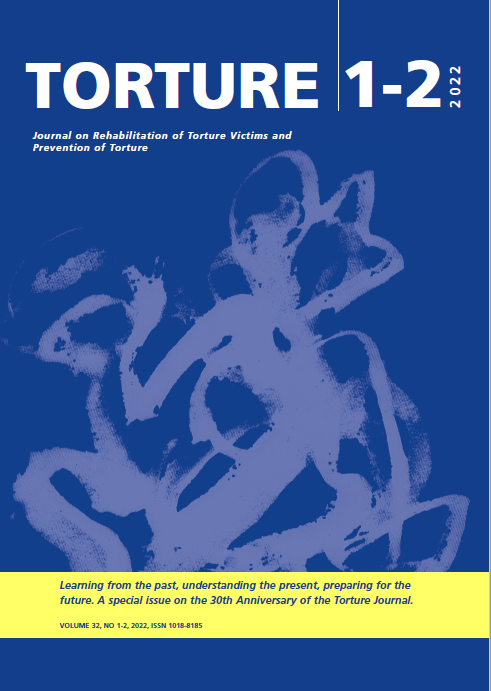Looking back at experiences from 30 years with documentation and prevention of torture
DOI:
https://doi.org/10.7146/torture.v32i1-2.130847Keywords:
Torture, documentation, prevention, Spain, public opinion, Kashmir, Zimbabwe, medical complicity, bribery, United Nations, SecurityAbstract
Contribution to the 30th Anniversary of the Torture Journal by Dr. Hans Draminsky Petersen. The author describes his more than 30-years’ of experience in conducting monitoring visits to detention centres in different countries with an analytical perspective on the elements that perpetuate torture.
References
Albrectsen, S.R. (1982). En baskisk læges død. Ugeskrift for Læger 144, 3755-3756. (In Danish).
Amnesty International (1980). Report of an Amnesty International mission to Spain 3-28 October 1979. Amnesty International. London.
Arendt, H. (2006). Truth and politics, between past and future – Eight exercises in political thoughts. Penguin Books. New York.
CPT. The Committee for the Prevention of Torture and Cruel, inhuman and Degrading Treatment or Punishment (1996 a). Report to the Spanish government on the visit to Spain 1-12 April 1991. Available from https://rm.coe.int/1680697de7
CPT. The Committee for the Prevention of Torture and Cruel, inhuman and Degrading Treatment or Punishment (1996 b). Report to the Spanish government on the visit to Spain 11-22 April 1994. Available from https://rm.coe.int/1680697dea
CPT. The Committee for the Prevention of Torture and Cruel, inhuman and Degrading Treatment or Punishment (1996 c). Report to the Spanish government on the visit to Spain 10-14 June 1994. Available from https://rm.coe.int/1680697dec
Gorostiza, J-M. L. (2009). Documentación de la tortura en detenidos incomunicados en El País Vasco desde el 2000 al 2008: Abordaje científico. Departamento de Justicia, Empleo y Seguridad Social. Vitoria-Gasteiz, Spain.
Gossman, P. (1993). The human rights crisis in Kashmir. Human Rights Watch and Physicians for Human Rights. New York.
El País (1984). Intxaurrondo, un gueto donde se opera contra ETA. Madrid, Spain.
Eppel, S. and Petersen, H.D. (2002). Rule of law, law and the health profession. Zimbabwe 2002. Dan Med Bull 49, 247-252.
Larsen, M., Petersen, H.D., Mannstaedt, M. and Skytt, G. (1995). Prevalence of exposure to organized violence among refugees from Kashmir. Torture 5, 14-17.
Morentin, B., Petersen, H.D., Callado, L.F., Idoyaga, M.I. and Meana, J.J. (2008). A follow-up investigation on the quality of medical documents from examinations of Basque incommunicado detainees. The role of the medical doctors and national and international authorities in the prevention of ill-treatment and torture. Forensic Sci Int 182, 57-65.
Nowak, M. (2007). Report of the Special Rapporteur on Torture Manfred Nowak. Addendum: mission to Jordan. UN General Assembly. New York.
Pérez-Sales, P., Morentin, B., Barrenetxea, O. and Navarro-Leshayas, M.A. (2016). Incommunicado detention and torture in Spain, part II: Enhanced credibility assessment based on the Istanbul Protocol. Torture 26, 8-20.
Petersen, H.D. and Rasmussen, O.V. (1980). Tortur I Spanien 1978-1979. Ugeskrift for Læger 142, 3298-3301. (In Danish).
Petersen, H.D. and Jacobsen, P. (1985). Psychical and physical symptoms after torture. Forensic Sci Int 29, 179-189.
Petersen, H.D. and Vedel, O.M. (1994). Assessment of evidence of human rights violations in Kashmir. Forensic Sci Int 68, 103-115.
Petersen, H.D. and Wandall, J.H. (1994). Evidence of organized violence among refugees from Indian-held Kashmir. Torture 4, 90-95.
Petersen, H.D. and Wandall, J.H. (1995). Evidence of physical torture in a series of children. Forensic Sci Int 75, 45-55.
Petersen, H.D., Lykke, J., Hougen, H.P. and Mannstaedt, M. (1998). Results of medical examinations of refugees from Burma. Dan Med Bull 45, 313-316.
Petersen, H.D., Worm, L., Olsen, M.Z., Ussing, B. and Hartling, O.J. (2000). Human rights violations in Burma /Myanmar. A two-year follow-up examination. Dan Med Bull 47, 359-363.
Petersen, H.D., Morentin, B., Calllado, L.F., Meana, J.J. and Idoyaga, I. (2002). Assessment of the quality of medical documents issued in central police stations in Madrid, Spain: The doctor’s role in the prevention of ill-treatment. J Forensic Sci 47 (2), 293-298.
Petersen, H.D. and Morentin, B. (2017). Detainees’ perception of the doctors and the medical institution in Spanish police stations: An impediment in the fight against torture and ill-treatment. Torture 27, 27-46.
Petersen, H.D. and Morentin, B. (2019). Assessing the level of credibility of allegations of physical torture. Forensic Sci Int 301, 263-270.
Pérez-Sales, P., Navarro-Lashayas, M.A., Plaza, A., Morentin, B. and Salinas, O.B. (2016). Incommunicado detention and torture in Spain. Part III: ‘Five days is enough’: the concept of torturing environment. Torture 26, 21-33.
UN (2002). United Nations Committee against Torture (CAT). Spain. CAT/C/CR/29/3.
UN (2004). United Nations’ report of the Special Rapporteur on the question of torture: Visit to Spain. 6. February 2004, E/CN.4/2004/56/Add.2.
Downloads
Published
How to Cite
Issue
Section
License
Copyright (c) 2022 Torture Journal

This work is licensed under a Creative Commons Attribution-NonCommercial-NoDerivatives 4.0 International License.
We accept that some authors (e.g. government employees in some countries) are unable to transfer copyright. The Creative Commons Licence Attribution-NonCommercial-NoDerivatives 4.0 International (CC BY-NC-ND 4.0) covers both the Torture Journal and the IRCT web site. The publisher will not put any limitation on the personal freedom of the author to use material contained in the paper in other works which may be published, provided that acknowledgement is made to the original place of publication.


